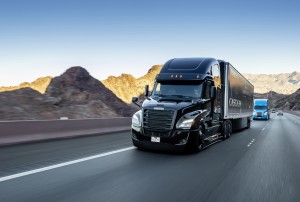Daimler AG plans to invest $570 million and create 200 jobs at its truck-oriented technical center in Portland, Oregon, to expedite the development automated driving for heavy-duty commercial trucks.
“As a leader of our industry, we’ve been pioneering automated trucking,” said Martin Daum, member of the Board of Management of Daimler AG with responsibility for Daimler Trucks & Buses
“In 2015, our Freightliner Inspiration Truck got the first road license ever for an automated commercial vehicle. Now we take automated trucking to the next level: we’re ready to launch the first partially automated new Freightliner Cascadia in 2019 – and next, we tackle highly automated trucks,” Daum said.
Daum said during a press conference at the Consumer Electronics show in Las Vegas that the highly automated trucks will improve safety, boost the performance of logistics and offer a great value proposition to customers.
(Daimler delivers E-Truck to Penske for testing. Click Here for the story.)
Highly automated driving is characterized as automated travel in defined areas and between defined hubs without any expectation of the system that a user will respond to a request to intervene. In commercial trucking, level 4 is the natural next step after level 2, increasing efficiency and productivity for customers, cutting costs per mile significantly.
Daum added Daimler Trucks is skipping the intermediate step of conditionally automated driving. The Level 3 automated driving does not offer truck customers a substantial advantage compared to the current situation as there are no corresponding benefits to compensate for the technology costs.
For now, the new Freightliner Cascadia offers partially automated driving features, making it the first-ever partially automated series production truck on North American roads. It also made its world premiere during today’s presentation of Daimler Trucks at CES.
With Active Drive Assist, Mercedes-Benz Actros, FUSO Super Great and Detroit Assurance 5.0 with Active Lane Assist available on Freightliner’s new Cascadia, Daimler Trucks is already bringing partially automated driving features into series production. The new system can independently brake, accelerate and steer.
(Click Here for more about Mercedes’ new Sprinter plant.)
Unlike systems that only work above a certain speed, Active Drive Assist / Detroit Assurance 5.0 make partially automated driving possible in all speed ranges for the driver for the first time in a series production truck. Active lateral control and the connection of longitudinal or lateral control in all speed ranges are new thanks to the fusion of radar and camera information.
Daimler Trucks is reassessing its view on platooning, which involves the electronic coupling of two or more trucks with significantly reduced distance between them to, in theory, improve aerodynamics and therefore save fuel.
The company tested platooning for several years, especially in the U.S., where benefits would be expected to be the most substantial. Results show that fuel savings, even in perfect platooning conditions, are less than expected.
Those savings are further diminished when the platoon gets disconnected and the trucks must accelerate to reconnect. Daimler’s analysis indicates there is no business case for customers driving platoons with new, highly aerodynamic trucks.
(To see more about Daimler AG’s restructuring plans, Click Here.)
Highly automated Level 4 trucks, however, offer advantages in today’s society where there is a growing desire for safer roads and more sustainable transport solutions. They can enhance safety in traffic thanks to a redundancy of systems and a multitude of sensors and systems that never get tired or lose attention – because today, a great majority of accidents are still due to human error.


Right always think about safety first whatever design or creative features due to moving equipments or trucking on the roads and reducing the air pollution continue to improve the healthy environment.